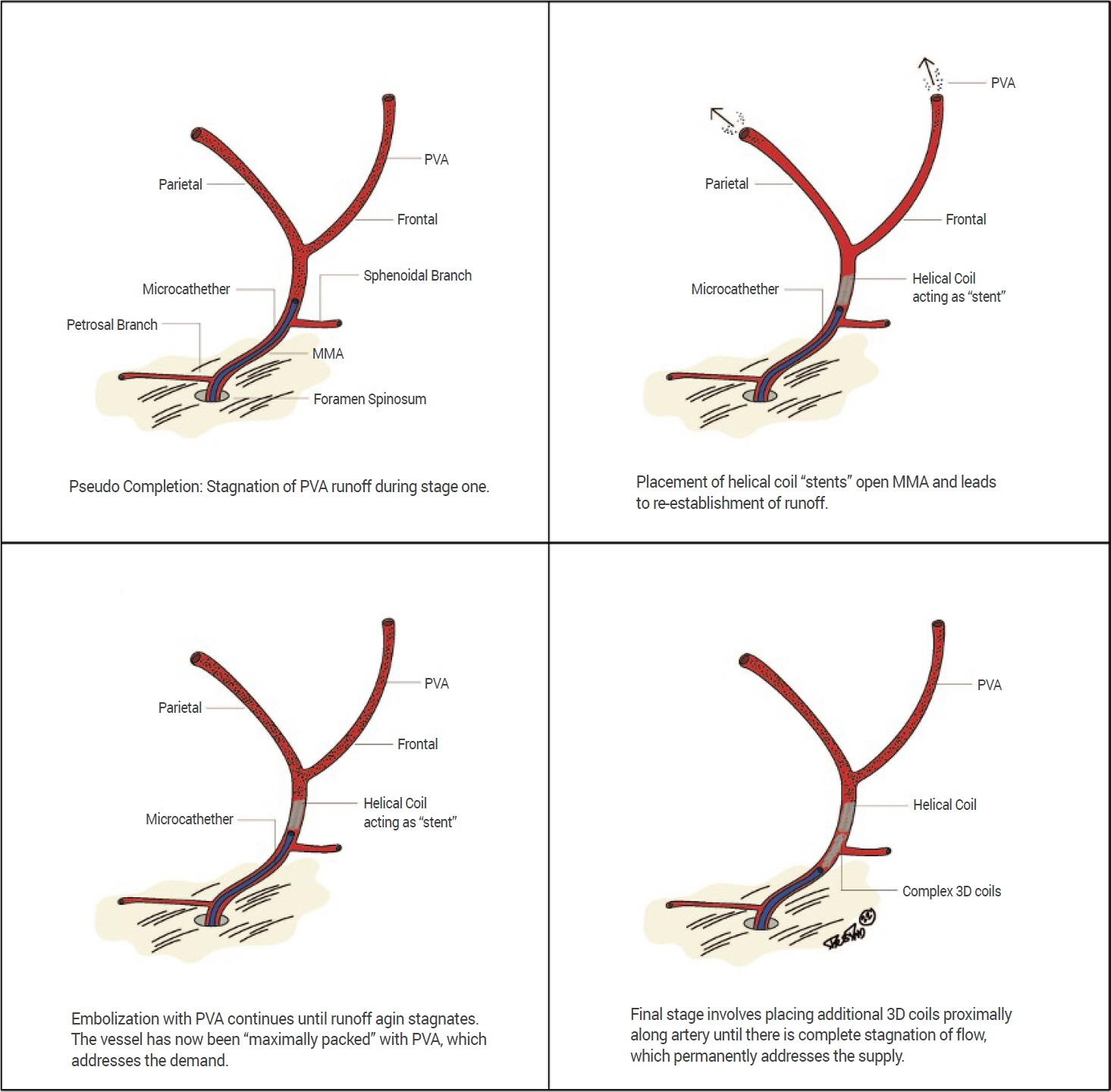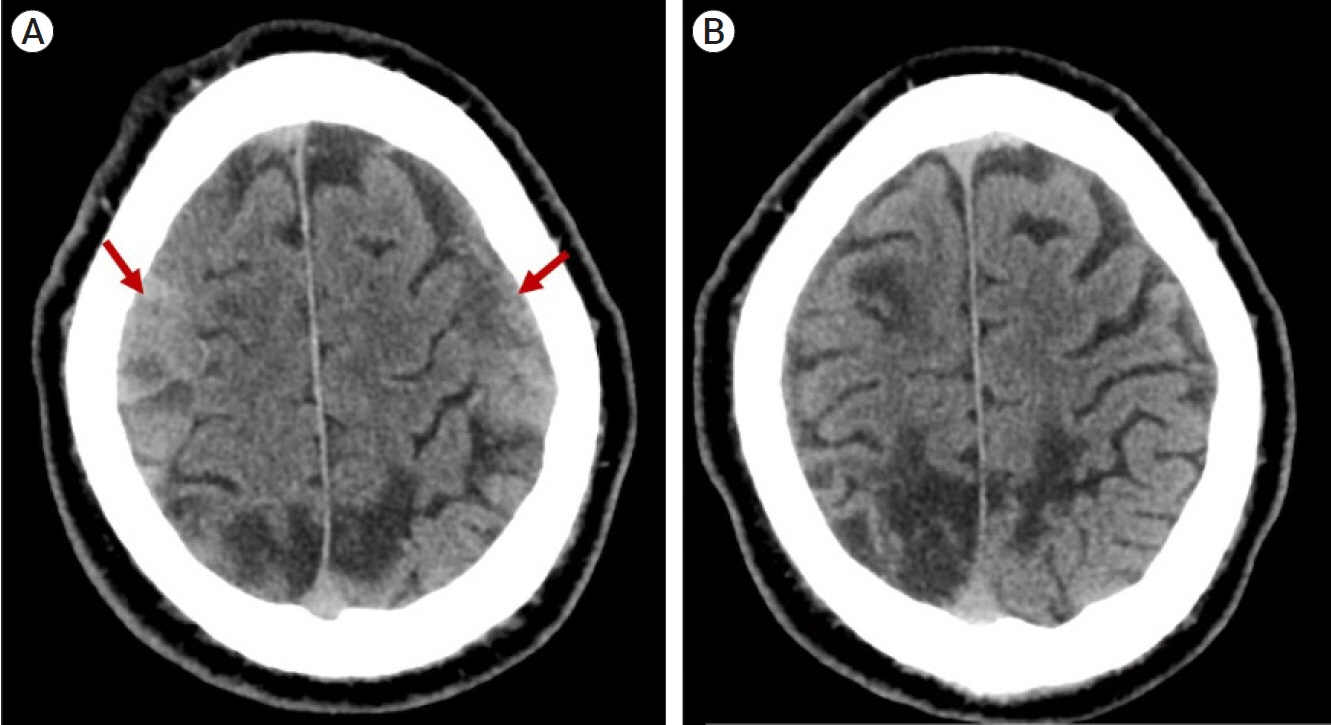J Cerebrovasc Endovasc Neurosurg.
2023 Jun;25(2):214-223. 10.7461/jcen.2023.E2022.08.001.
Helical coils augment embolization of the middle meningeal artery for treatment of chronic subdural hematoma: A technical note
- Affiliations
-
- 1Department of Neurological Surgery, University of California, San Diego, CA, USA
- KMID: 2543519
- DOI: http://doi.org/10.7461/jcen.2023.E2022.08.001
Abstract
- Embolization of the middle meningeal artery (MMA) is a safe and effective adjunct in the treatment of chronic subdural hematoma. While prior authors describe the use of coils to assist embolization by preventing reflux through eloquent collaterals, we de- scribe the use of coils to further open the MMA, allowing the administration of greater amounts of embolisate for a more robust embolization. The objective of this study was to demonstrate that helical coils can safely open the MMA following the administration of polyvinyl alcohol (PVA) particles. This allows for more embolisate to be administered into the MMA for more effective treatment. A retrospective review was conducted at our institution including intraoperative images and postoperative clinical and radiographic follow up. Failure rates using MMA embolization with PVA and helical coil augmentation were compared to failure rates in the literature of MMA embolization with PVA or ethylene vinyl-alcohol copolymer alone. A total of 8 cases were reviewed in which this technique was implemented. There were no immediate complications after treatment. All patients that underwent helical coil embolization following the administration of PVA had increased amount of embolisate delivered into the MMA. All patients at follow up had resolution of the subdural hematoma on outpatient imaging. Helical coil embolization allows for more embolisate administration into the MMA and provides a technical advantage for patients that fail traditional techniques of embolization. Case series are taking place to further test this hypothesis and identify the ideal patient population that may gain maximal yield from this novel technique.
Keyword
Figure
Reference
-
1. Balser D, Farooq S, Mehmood T, Reyes M, Samadani U. Actual and projected incidence rates for chronic subdural hematomas in United States Veterans Administration and civilian populations. J Neurosurg. 2015; Nov. 123(5):1209–15.
Article2. Ban SP, Hwang G, Byoun HS, Kim T, Lee SU, Bang JS, et al. Middle meningeal artery embolization for chronic subdural hematoma. Radiology. 2018; Mar. 286(3):992–9.
Article3. Catapano JS, Ducruet AF, Nguyen CL, Baranoski JF, Cole TS, Majmundar N, et al. Middle meningeal artery embolization for chronic subdural hematoma: an institutional technical analysis. J Neurointerv Surg. 2021; Jul. 13(7):657–60.
Article4. Chen JW, Xu JC, Malkasian D, Perez-Rosendahl MA, Tran DK. The mini-craniotomy for cSDH revisited: new perspectives. Front Neurol. 2021; May. 12:660885.5. Clinical Trials Database; U.S. National Library of Medicine at the National Institutes of Health. Middle meningeal artery embolization AND chronic subdural hematoma. https://clinicaltrials.gov/ct2/results?term=middle+meningeal+artery+-embolization&cond=chronic+subdural+hematoma&age_v=&gndr=&type=Intr&rslt=&Search=Apply (Accessed 09/25/2021).6. Cofano F, Pesce A, Vercelli G, Mammi M, Massara A, Minardi M, et al. Risk of recurrence of chronic subdural hematomas after surgery: a multicenter observational cohort study. Front Neurol. 2020; Nov. 11:560269.
Article7. Edlmann E, Giorgi-Coll S, Whitfield PC, Carpenter KL, Hutchinson PJ. Pathophysiology of chronic subdural haematoma: inflammation, angiogenesis and implications for pharmacotherapy. J Neuroinflammation. 2017; May. 14(1):108.
Article8. Gilligan J, Gologorsky Y. Middle meningeal artery embolization for chronic subdural hematoma: current state and future directions. World Neurosurg. 2020; Jul. 139:622–3.
Article9. Gomez-Paz S, Akamatsu Y, Salem MM, Enriquez-Marulanda A, Robinson TM, Ogilvy CS, et al. Upfront middle meningeal artery embolization for treatment of chronic subdural hematomas in patients with or without midline shift. Interv Neuroradiol. 2021; Aug. 27(4):571–6.10. Hashimoto T, Ohashi T, Watanabe D, Koyama S, Namatame H, Izawa H, et al. Usefulness of embolization of the middle meningeal artery for refractory chronic subdural hematomas. Surg Neurol Int. 2013; Aug. 4:104.11. Holl DC, Volovici V, Dirven CMF, Peul WC, van Kooten F, Jellema K, et al. Pathophysiology and nonsurgical treatment of chronic subdural hematoma: from past to present to future. World Neurosurg. 2018; Aug. 116:402–11.
Article12. Ironside N, Nguyen C, Do Q, Ugiliweneza B, Chen CJ, Sieg EP, et al. Middle meningeal artery embolization for chronic subdural hematoma: a systematic review and meta-analysis. J Neurointerv Surg. 2021; Oct. 13(10):951–7.
Article13. Jung YG, Jung NY, Kim E. Independent predictors for recurrence of chronic subdural hematoma. J Korean Neurosurg Soc. 2015; Apr. 57(4):266–70.
Article14. Kan P, Maragkos GA, Srivatsan A, Srinivasan V, Johnson J, Burkhardt J, et al. Middle meningeal artery embolization for chronic subdural hematoma: a multi-center experience of 154 consecutive embolizations. Neurosurgery. 2021; Jan. 88(2):268–77.15. Khorasanizadeh M, Salih M, Harris D, Ogilvy CS. Technique to “trap” a segment of the middle meningeal artery for embolization of a carotid cavernous fistula: 2-dimensional operative video. Oper Neurosurg (Hagerstown). 2021; Oct. 13. 21(5):e444.16. Kim E. Embolization therapy for refractory hemorrhage in patients with chronic subdural hematomas. World Neurosurg. 2017; May. 101:520–7.
Article17. Leroy HA, Aboukaïs R, Reyns N, Bourgeois P, Labreuche J, Duhamel A, et al. Predictors of functional outcomes and recurrence of chronic subdural hematomas. J Clin Neurosci. 2015; Dec. 22(12):1895–900.
Article18. Link TW, Boddu S, Marcus J, Rapoport BI, Lavi E, Knopman J. Middle meningeal artery embolization as treatment for chronic subdural hematoma: a case series. Oper Neurosurg (Hagerstown). 2018; May. 14(5):556–62.
Article19. Link TW, Boddu S, Paine SM, Kamel H, Knopman J. Middle meningeal artery embolization for chronic subdural hematoma: a series of 60 cases. Neurosurgery. 2019; Dec. 85(6):801–7.20. Link TW, Rapoport BI, Paine SM, Kamel H, Knopman J. Middle meningeal artery embolization for chronic subdural hematoma: endovascular technique and radiographic findings. Interv Neuroradiol. 2018; Aug. 24(4):455–62.21. Matsumoto H, Hanayama H, Okada T, Sakurai Y, Minami H, Masuda A, et al. Which surgical procedure is effective for refractory chronic subdural hematoma? Analysis of our surgical procedures and literature review. J Clin Neurosci. 2018; May. 49:40–7.
Article22. Mishra A, Kumar A, Mathur A, Kumar V, Sreen A. Coil assisted glue embolization to improve safety and accuracy in endovascular management of Vein of Galen patients. Clin Neurol Neurosurg. 2021; Apr. 205:106652.
Article23. Moshayedi P, Liebeskind DS. Middle meningeal artery embolization in chronic subdural hematoma: implications of pathophysiology in trial design. Front Neurol. 2020; Aug. 11:923.
Article24. Ng S, Derraz I, Boetto J, Dargazanli C, Poulen G, Gascou G, et al. Middle meningeal artery embolization as an adjuvant treatment to surgery for symptomatic chronic subdural hematoma: a pilot study assessing hematoma volume resorption. J Neurointerv Surg. 2020; Jul. 12(7):695–9.25. Nia AM, Srinivasan VM, Lall RR, Kan P. Middle meningeal artery embolization for chronic subdural hematoma: a national database study of 191 patients in the united states. World Neurosurg. 2021; Sep. 153:e300–7.26. Peng D, Zhu Y. External drains versus no drains after burrhole evacuation for the treatment of chronic subdural haematoma in adults. Cochrane Database Syst Rev. 2016; Aug. 2016(8):CD011402.
Article27. Rutledge C, Baranoski JF, Catapano JS, Jadhav AP, Albuquerque FC, Ducruet AF. Resolution of an enlarging subdural haematoma after contralateral middle meningeal artery embolisation. BMJ Case Rep. 2021; Apr. 14(4):e017530.
Article28. Santarius T, Kirkpatrick PJ, Ganesan D, Chia HL, Jalloh I, Smielewski P, et al. Use of drains versus no drains after burrhole evacuation of chronic subdural haematoma: a randomised controlled trial. Lancet. 2009; Sep. 374(9695):1067–73.
Article29. Shotar E, Meyblum L, Premat K, Lenck S, Degos V, Grand T, et al. Middle meningeal artery embolization reduces the post-operative recurrence rate of at-risk chronic subdural hematoma. J Neurointerv Surg. 2020; Dec. 12(12):1209–13.30. Sjåvik K, Bartek J Jr, Sagberg LM, Henriksen ML, Gulati S, Ståhl FL, et al. Assessment of drainage techniques for evacuation of chronic subdural hematoma: a consecutive population-based comparative cohort study. J Neurosurg. 2017; Jun. 133(4):1113–9.31. Sousa EB, Brandão LFS, Tavares CB, Borges IBC, Neto NGF, Kessler IM. Epidemiological characteristics of 778 patients who underwent surgical drainage of chronic subdural hematomas in Brasília, Brazil. BMC Surg. 2013; Mar. 13:5.
Article32. Tamura R, Sato M, Yoshida K, Toda M. History and current progress of chronic subdural hematoma. J Neurol Sci. 2021; Oct. 15. 429:118066.
Article33. Torihashi K, Sadamasa N, Yoshida K, Narumi O, Chin M, Yamagata S. Independent predictors for recurrence of chronic subdural hematoma: a review of 343 consecutive surgical cases. Neurosurgery. 2008; Dec. 63(6):1125–9. discussion 1129.34. Xu C, Zhu Y; External drains versus no, Yang X, Wei M, et al. Randomized controlled study on the curative effects of twist-drill craniotomy and burr-hole craniotomy in the treatment of chronic subdural hematoma. Exp Ther Med. 2018; Aug. 16(2):959–65.35. Yadav YR, Parihar V, Namdev H, Bajaj J. Chronic subdural hematoma. Asian J Neurosurg. 2016; Oct-Dec. 11(4):330–42.36. Yang W, Huang J. Chronic subdural hematoma: epidemiology and natural history. Neurosurg Clin N Am. 2017; Apr. 28(2):205–10.
- Full Text Links
- Actions
-
Cited
- CITED
-
- Close
- Share
- Similar articles
-
- Retrograde Middle Meningeal Artery Embolization through Mini Craniotomy for Subdural Hematoma Evacuation: A Technical Note
- Endovascular surgery for chronic subdural hematoma
- Usefulness of Middle Meningeal Embolization to Prevent Recurrent Spontaneous Chronic Subdural Hemorrhage
- Neovascularization in Outer Membrane of Chronic Subdural Hematoma : A Rationale for Middle Meningeal Artery Embolization
- Neovascularization in Outer Membrane of Chronic Subdural Hematoma : A Rationale for Middle Meningeal Artery Embolization




